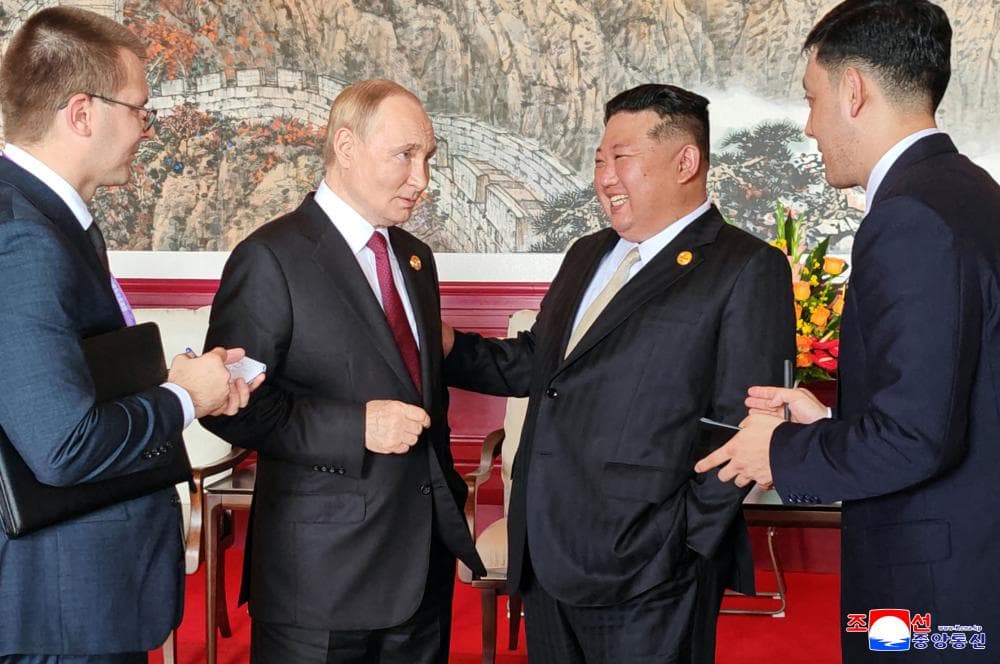Ukraine war briefing: Kim Jong-un celebrates sharing ‘blood, life and death’ with Russia
The North Korean leader, Kim Jong-un, has highlighted how his country and Russia had shared “blood, life and death” in the Ukraine war in a new year’s greeting to Vladimir Putin. In the message, published by the state-run KCNA news agency, Kim said 2025 was a “really meaningful year” for the bilateral alliance that was consolidated by “sharing blood, life and death in the same trench”. North Korea confirmed in April that it had deployed troops to support Russia’s military campaign against Ukraine and that its soldiers had been killed in combat. Earlier this month, Pyongyang acknowledged that it had sent troops to clear mines in Russia’s Kursk region in August 2025. Several powerful explosions rocked Kyiv on Saturday as authorities warned that the Ukrainian capital was under threat of missile attack. “Explosions in the capital. Air defence forces are operating. Stay in shelters!” Kyiv’s mayor, Vitali Klitschko, wrote on Telegram. Ukraine’s air force also announced a countrywide air alert in the early hours of Saturday and said on social media that drones and missiles were moving over several Ukrainian regions, including the capital. Agence France-Presse journalists in Kyiv heard several loud explosions, some accompanied by bright flashes that lit the horizon orange. A military Telegram channel said cruise and ballistic missiles were being deployed in the city. Moscow has accused the EU of trying to “torpedo” an agreement between Russia and Ukraine ahead of a meeting between Zelenskyy and Donald Trump in Florida on Sunday. Russia’s deputy foreign minister, Sergei Ryabkov, said the proposal drawn up with Zelenskyy’s input “differs radically” from points initially drawn up by US and Russian officials in contacts this month. “Our ability to make the final push and reach an agreement will depend on our own work and the political will of the other party,” Ryabkov said on Russian television. “Especially in a context where Kyiv and its sponsors – notably within the European Union, who are not in favour of an agreement – have stepped up efforts to torpedo it.” Ryabkov added: “Without an adequate resolution of the problems at the origin of this crisis, it will be quite simply impossible to reach a definitive accord.” He said any deal had to “remain within the limits” fixed by Trump and Putin when they met in Alaska in August, or else “no accord can be reached”. Volodymyr Zelenskyy has accused Russia of using apartment blocks in Belarus to attack Ukrainian targets. “We note that the Russians are trying to bypass our defensive interceptor positions through the territory of neighbouring Belarus,” the Ukrainian president wrote on Telegram. He said Ukrainian intelligence had observed that Belarus was deploying equipment to carry out its attacks “in Belarusian settlements near the border, including on residential buildings”. “Antennae and other equipment are located on the roofs of ordinary five-storey apartment buildings, which help guide Shaheds [drones] to targets in our western regions. This is an absolute disregard for human lives.” Moscow may be stationing new Oreshnik nuclear-capable hypersonic ballistic missiles at a former airbase in eastern Belarus, two US researchers have claimed, after studying satellite imagery. Jeffrey Lewis and Decker Eveleth said they based their finding on imagery from Planet Labs, a commercial satellite firm, that showed features consistent with a Russian strategic missile base. Lewis and Eveleth said they were 90% certain that mobile Oreshnik launchers would be stationed at the former airbase near Krichev, 307km east of the Belarus capital, Minsk. The researchers said reviews of the Planet Labs imagery revealed a hurried construction project that began between 4 and 12 August and showed features consistent with those of a Russian strategic missile base. One “dead giveaway” in a 19 November photo is a “military-grade rail transfer point” enclosed by a security fence to which missiles, their mobile launchers and other components could be delivered by train, said Eveleth. Russia’s defence ministry claimed on Friday it had captured a new village in the south-eastern Zaporizhzhia region. The ministry wrote on Telegram it had seized the village of Kosivtseve, north of the town of Huliaipole, which has come under severe Russian pressure in recent weeks. It said Russian troops had taken more than 23 sq km of territory in securing the village, giving the “east” group of forces “a base for further offensive actions”. The defence ministry said its forces had deployed drones to prevent fresh Ukrainian troops from entering Huliaipole.






